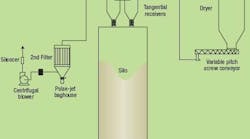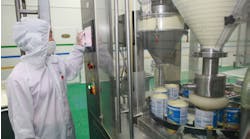Question from May's Chemical Processing
A corrosive material is transported by vacuum pneumatic conveyor from a dryer to a silo. The condition at the discharge of the dryer is about 90°F with 75% relative humidity. Since commissioning, during the summer, the blower has suffered reliability problems: seal corrosion, bearing failure, motor trips and noisy operation. In particular, bearing failure has been the main problem with this blower. Failures are worse in the fall and winter than in the summer. Current readings on the blower tend to increase slightly during the winter but the draw seems normal until sudden failure of the seals or bearings. What is the likely cause and what can we do to reduce reliability problems?
Figure 1. Switching to steam sterilization may affect seals, bearings and pump performance.
Reduce the relative humidity
During the winter months, as the air and product progress through the system the temperature drops appreciably. If the air starts out from the bottom of the dryer at 90°F and 75% relative humidity, by the time it gets past the silo its temperature has probably dropped and hence the relative humidity has increased. At some point the humidity begins to condense and dissolve some of the corrosive. This now corrosive water is being deposited on the fan and bearings causing them to fail. The high humidity also would increase the pressure drop across the bag house, resulting in the slight increase in current during winter. The corrosive water wouldn’t be stopped by either the bag house or by the second filter; in fact, it would probably become more concentrated as it passed through the cake.
The solution would be to reduce the relative humidity at the dryer, reduce the relative humidity and condensation in the system or get the fan out of the path. We could reduce the condensation by insulating all of the piping and equipment between the dryer and the blower. If needed, we could add an air pre-heater where the air enters the system at the outlet of the dryer. We may need to add some heat tracing, depending on ambient conditions. Alternatively, we could construct a heated enclosure over the entire process.
To get the fan out of the path of the condensate we could use a pressurized pneumatic transport system rather than a vacuum transport system.
Patrick Richards, sr. instrumentation designer,
Irving Oil Ltd., Saint John, N.B.
Dissipate static electricity
The bearing failures make me believe that there are static electricity charges being dissipated through the blower bearings. As the static electricity current arcs through the bearings the bearing surfaces become pitted. After just a few minutes of service time under these conditions an early failure for these bearings is imminent.
When material is vacuum conveyed there are static electrical charges built up. There should be a system to dissipate these static electricity charges other than through the blower bearings. An examination of the vacuum conveyor system should be made to look for the possibility that the static electricity charges are being dissipated through the blower bearings.
Mike Dailey, P.E., project manager
Bay-Tec Engineering Inc., Brea, Calif.
Focus on the bearings and seals
The problem appears to be blower failure. The cause may be bearings or seal failure. A possible solution may be identified through research:
- Seal improvement to a more-corrosion-resistant product more compatible with the conveyed material.
- Using sealed bearings on the blower or using autolubers on the blower fan bearings.
- Reconfiguring the blower so the bearings aren’t exposed to the air stream in contact with the conveyed material.
- Keeping the blower seals and bearings at a slightly elevated temperature to prevent thermal expansion, which may have led to seal failures.
Gary Shamshoian, P.E., sr. mechanical engineer
Genentech, Inc., South San Francisco, Calif.
Go plastic
Consider changing the blower to a completely plastic design, including Teflon coated bearings and/or Kevlar. Use neoprene seals. This should avoid corrosion, noise and moisture adsorption.
Emilio Malaguti, technical manager
Chemtron, Hialeah, Fla.
Check for powder carry-over
Probable root causes are:
- air leakage in the system due to vacuum conveying;
- at lower temperature, acid condensation; and
- selection of materials of construction.
It seems to be the case of acid getting condensed and damaging the seal and then bearings. Higher friction leads to noisy operation and higher current consumption due to higher mechanical losses. Is there any powder carryover through the pulse jet bag house? It can lead to imbalance of rotor and sudden failure.
Recommended remedial actions are:
- choice of a more suitable material of construction for bearings and seal, if possible;
- selection of bag specification or proper installation/maintenance of the bags in the housing to avoid powder carry-over, if any; and
- use of some type of heater at the air intake, particularly in fall and winter, to avoid condensation of corrosive liquid.
Kamal Parikh, sr. general manager
Reliance Industries Ltd., Surat, Gujarat, India
Kayo condensation
Assuming that the fall and winter exterior air temperatures are significantly below the dew point of the air from the dryer discharge, then condensation is the likely culprit. A corrosive material plus water is a nice pair to corrode seals and bearings. The higher amp draw during the cooler months is indicative of denser air.
Jeff Shifflette, sr. process engineer
Chemtura Corp., Memphis, Tenn.
September's Puzzler
Our clean-in-place (CIP) system now involves a hot water rinse, followed by a caustic rinse, followed by a biocide in a phosphoric acid solution. The new owners of the plant want to make a change. They propose switching the acid rinse to a steam sterilization step that will be carried out at about 230°F. We are worried about the mechanical seals in process pumps. The pump vendor doesn’t recommend the seals above 225°F and also is concerned about the effect on bearings and pump performance. Do you think agitator seals also will be affected? What improvements do you feel are needed to comply with our new owners’ wishes without extensive changes throughout the plant?
Figure 2. Switching to steam sterilization may affect seals, bearings and pump performance
Send us your comments, suggestions or solutions for this question by August 10, 2007. We’ll include as many of them as possible in the September 2007 issue and all on CP.com. Send visuals — a sketch is fine. E-mail us at [email protected] or mail to ProcessPuzzler, Chemical Processing, 555 W. Pierce Rd., Suite 301, Itasca, IL 60143. Fax: (630) 467-1120. Please include your name, title, location and company affiliation in the response.
And, of course, if you have a process problem you’d like to pose to our readers, send it along and we’ll be pleased to consider it for publication.


